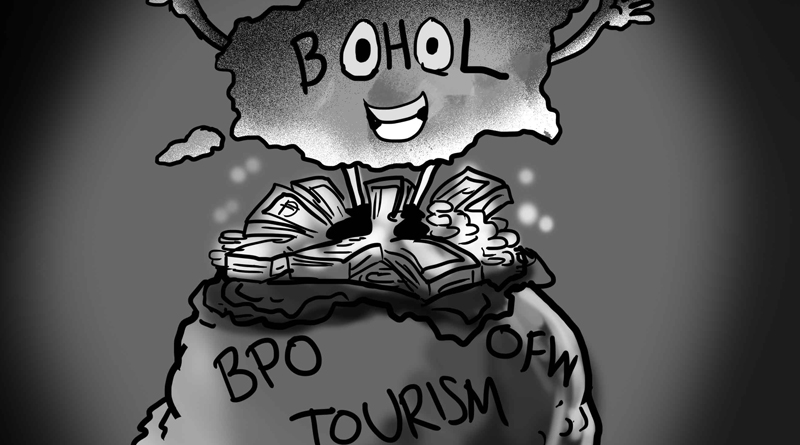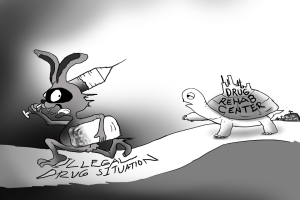 IT WAS 15 YEARS AGO, when Bohol was No 16 among the 20 poorest provinces in the country. But  per the United Nations Poverty Index,  by 2006 Bohol  eclipsed that going No 56 among 72 provinces, exhibiting even one of the fastest moving journey out of the morass of poverty.
IT WAS 15 YEARS AGO, when Bohol was No 16 among the 20 poorest provinces in the country. But  per the United Nations Poverty Index,  by 2006 Bohol  eclipsed that going No 56 among 72 provinces, exhibiting even one of the fastest moving journey out of the morass of poverty.
Today, Bohol is poised to still  become a “rich” province because of three reasons.
The   three chief dollar earning industries in the Philippines are becoming a major force of the Bohol economy: the OFWs Money , the Tourism and  the BPO (Business Processing) industries.
Almost  every Boholano household today  has at least one OFW member working abroad and remitting part of his earnings to his family in Bohol. Many of the  galaxy of new cars and housing units one sees around are the so-called “katas ng OFW”– the fruit juice of the OFW efforts. Ask your local  bankers , how much they are relying on the OFW  money being  remitted yearly to explain their bank’s  very  high deposit growth over the years.
Lest one forgets, according to (Santiago 2003), the Boholanos were one of the first OFWs of the country -when in the 1800’s a group of skilled  local pearl divers were imported to work in Australia. Today, there are 9-10 million OFWs who remitted about US$ 27-Billion in 2014 or ( P1.2 Trillion-that’s one third of the entire Philippines national budget). This is growing by 6%every year, indicating  either the OFWs are increasing or the present ones are sending more money.
Empirical studies showed there is a correlation  between the OFW remittance receipts  and the reduction of poverty of their original households (Yang and Martinez, 2005).  There is also  quantitative evidence.
For instance,  a study done by the Peace Equity Access for Community Empowerment Foundation – it discovered  that 75% of the poorest towns in the country, only 3 to 6%of the population there had OFWs while 60% of the “better off” towns had at least 9-22% of their population working abroad.
The peso:dollar exchange just hit P47:US$1 which is good for the OFW families.
In the meantime, “World Tourism and Travel” is big business with a value of US$ 7.6-Trillion or 10% of the world’s entire GDP (Gross Domestic Product) employing 277 Â million people worldwide.
The Philippines is ranked by the “World and Trade Tourism Council” as No 67 Â of 184 nations, indicating that Tourism is a major force in RP’s economy as well. And Bohol is still one of the most preferred tour destinations in the country.
The same council said foreign visitors spent P256-B in 2014 here,representing  69% of the country’s total exports while the P 533-B value is 4.2% of the country’s GDP.
Meantime, DOT (Department of Tourism) secretary Ramon Jimenez claims that RP made a tourism -related income of US$-5-B from foreign tourists and P 1-Trillion from domestic visitors in 2014. He figures that next year’s foreign figures should tally US$-6-B and anything beyond that is already a  “major break through” for the country.
The country had already  given up its ambitious target of 10 million tourists in 2016 (content with 6 million) but focused instead  on revenues generated which is a function of the number of days a tourist stays and the average expenditure he makes while here.
Tourism directly employs 4.9 million Filipinos representing  about 11% of the total work force -not counting the indirect workers in the food and drink suppliers etc to the industry.  Thus, Tourism is the fifth largest employer industry.According to Jimenez, Tourism is also the third largest dollar earning industry , next to the BPO which the country now lords over  globally eclipsing erstwhile leader India.
Another source- Â Philippine Statistical Authority, on the other hand, tracked down US$20.7 Billion foreign and P983_m local tour receipts in 2014Â – a 14% increase from 2013 levels. This represents 7.8% of GDP,according to the them. Â The contributions came from : Accommodation (32%), Shopping (15.6%), Miscellaneous (15%), Transportation (13%), Entertainment and Recreation (10%), Travel agents and tour operators (8%) and Food and Beverage only a low (4.7%).
Government has  also responded in kind. The 2016 budget for Tourism is P3.6-B which is 44% higher than 2013’s P 2.5-B. In fact, the government had already invested a total of P54-B in “tourism-related” roads under the aegis of the Aquino administration.  “The Tourism Department has a separate Road Budget which it implements in coordination with the DPWH (Department of Public Works and Highways)”, according to the DOT chief.
He has always said “It’s More fun in the Philippines” and its partly because of its friendly, caring and English speaking Filipinos”- counting the hospitable Boholanos, among the very best of the kind.” The Philippines is its people. Its people are the Philippines.” Jimenez said that many in the Philippines will “work without pay if it means bringing tourists to their respective places.”
Bohol participates in this Tourism blessing -directly  hiring thousands of native Boholanos and indirectly benefiting many industries in agriculture, fisheries , transportation and handicrafts.
Meantime, the “third leg “of the “Bohol Dollar Tripod” is the IT-BPO industry for which PLDT had invested P600-M Â in Bohol in fiber optic technology last year, converting Tagbilaran and Bohol among the promising “call center” havens in the country. It is Bohol’s pool of educated graduates and the fantastic Rest and Recreation ambiance of the province that make the province as such. Â With a little more technology refinement – the province will be a BPO magnet in the near future.
The third-largest dollar earner in the Philippines is the IT-BPO industry, according to Jose Mari Mercado, President of the IT- BPO Association of the Philippines. The nation, in fact, has knocked out India as the world’s largest BPO Â source- earning in 2014 alone a huge US$ 18.9-Billion in revenues.
Compared to OFW remittances that grows only 6%  p.a., the BPO industry receipts have grown by 15% p.a-expecting to garner US$21,9-B in 2015 and by 2017 – US$ 28.9-Billion, thus will  even overtake the OFW total remittances.
So, in case one is dreaming of flying to those “greener pastures” abroad or in other provinces- think of the prosperity and opportunities that may be sitting in our own home province.
“The grass on other side is not always greener.”
For comments: email to dejarescobingo@yahoo.com or bohol-rd@mozcom.com








Be First to Comment